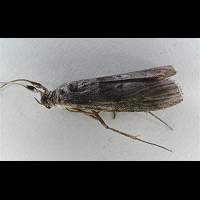Phycita roborella
We hardly ever show pictures on our website in which animals are dead. But in the case of Phycta roborella we make an exception. The animal in the pictures clearly has a sinuation at the base of the antennae. This is not unusual in some groups of moths. In the case of Pyralid Moths these are regularly found in males of species belonging to the Phycitinae subfamily. We don't know what purpose these sinuations have. As they appear in males only, it must have something to do with the animal's love life. The thing is a sinuation of the antenna with growing on it a bunch of very big scales. The moth itself is easy to identify because of the nice arrangement of black, grey and red patches all over the wings. However, this is a variable species. In quite some animals black is predominant and some of these darker moths are very hard to identify indeed. Reaching a wingspan of 24 to 30mm this is quite a large micromoth.
The egg hatches in September and the caterpillar eats to the end of September or the beginning of November. Then it spins together a couple of leaves and between them it overwinters. After overwintering it continues feeding to the end of May. It then pupates in the ground, among leaf litter or under loose bark. In June the first adults moths will appear. Even though the caterpillars of Phycita roborella are occasionally found on apple and pear, their usual food source is the oak.
This species is on the wing for a very long time: from June to the beginning of October. The greatest number however flies about in July and August. Phycita roborella is active during the night only, but comes to light easily and also freely to sugar and flowers. You have to take pictures on location, for this species doesn't like to be disturbed at all. A species of light soils, widely spread and quite common in most of England and the south of Ireland.
We hardly ever show pictures on our website in which animals are dead. But in the case of Phycta roborella we make an exception. The animal in the pictures clearly has a sinuation at the base of the antennae. This is not unusual in some groups of moths. In the case of Pyralid Moths these are regularly found in males of species belonging to the Phycitinae subfamily. We don't know what purpose these sinuations have. As they appear in males only, it must have something to do with the animal's love life. The thing is a sinuation of the antenna with growing on it a bunch of very big scales. The moth itself is easy to identify because of the nice arrangement of black, grey and red patches all over the wings. However, this is a variable species. In quite some animals black is predominant and some of these darker moths are very hard to identify indeed. Reaching a wingspan of 24 to 30mm this is quite a large micromoth.
The egg hatches in September and the caterpillar eats to the end of September or the beginning of November. Then it spins together a couple of leaves and between them it overwinters. After overwintering it continues feeding to the end of May. It then pupates in the ground, among leaf litter or under loose bark. In June the first adults moths will appear. Even though the caterpillars of Phycita roborella are occasionally found on apple and pear, their usual food source is the oak.
This species is on the wing for a very long time: from June to the beginning of October. The greatest number however flies about in July and August. Phycita roborella is active during the night only, but comes to light easily and also freely to sugar and flowers. You have to take pictures on location, for this species doesn't like to be disturbed at all. A species of light soils, widely spread and quite common in most of England and the south of Ireland.




